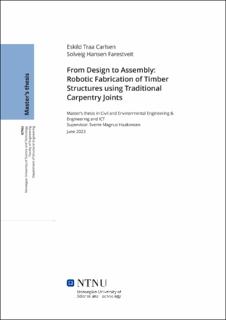| dc.contributor.advisor | Haakonsen, Sverre Magnus | |
| dc.contributor.author | Carlsen, Eskild Traa | |
| dc.contributor.author | Farestveit, Solveig Hansen | |
| dc.date.accessioned | 2023-10-02T17:19:32Z | |
| dc.date.available | 2023-10-02T17:19:32Z | |
| dc.date.issued | 2023 | |
| dc.identifier | no.ntnu:inspera:146720801:34557361 | |
| dc.identifier.uri | https://hdl.handle.net/11250/3093546 | |
| dc.description.abstract | Bygg- og anleggsbransjen har et behov for, og en mulighet til, digitalisering. Ved å benytte digitale verktøy som computer-aided manufacturing (CAM) og computer-aided design (CAD) kan produksjonen økes ved å effektivisere og automatisere tidkrevende oppgaver. Tradisjonelle treforbindelser blir stadig mer populære ettersom de kan produseres effektivt og nøyaktig ved hjelp av automatiserte verktøy som industrielle roboter.
Tre er et materiale som etterspørres i økende grad på grunn av sine miljøvennlige egenskaper. Det er et allsidig materiale med høy styrke i forhold til vekt, men dets anisotrope egenskaper gjør det sterkt avhengig av brukerens kunnskap om dets struktur. Treelementer er vanligvis sammenføyd ved hjelp av metallforbindelser som skruer og bolter. Imidlertid er det en økende etterspørsel etter ikke-destruktive og gjenbrukbare forbindelsesmetoder som er mer miljøvennlige. Motivasjonen for å erstatte metallforbindere med tradisjonelle treforbindelser er drevet av ønsket om miljøvennlige, estetisk tiltalende, og ensartede strukturer. I tillegg øker fokuset på prinsippet om design for demontering.
Denne avhandlingen har som mål å utvikle en design-til-produksjon generator for trekonstruksjoner ved hjelp av CAD- og CAM-teknologier, sammen med designprogramvaren Rhinoceros 3D, Grasshopper og plugins. FEM-verifiseringer utføres med Karamba 3D, og treelementene bearbeides ved hjelp av en seksakset industrirobot. Generatoren henter inspirasjon fra tradisjonelt norsk grindbygg-design. Ved å angi senterlinjer og tverrsnittsmål utfører generatoren kapasitetskontroller, oppretter verktøybaner og eksporterer instruksjoner til en industrirobot. Roboten bearbeider deretter de angitte elementene, slik at den lastbærende konstruksjonen kan monteres for hånd.
Evnene til verktøybanene og industriroboten testes grundig gjennom fresing av ulike testprøver og en case-studie fokusert på en avansert forbindelse. I en annen case-studie evalueres generatoren gjennom design og konstruksjon av en trekonstruksjon.
Begge case-studiene produserte de ønskede elementene med hastighet og presisjon. Utfordringer knyttet til singulariteter og kalibrering undersøkes, og strukturen monteres effektivt uten å kompromittere elementene. Disse case-studiene bidrar til å verifisere fleksibiliteten til den robotbaserte løsningen og vise frem demonterbare strukturer. | |
| dc.description.abstract | The construction industry has a need, and an opportunity, for digitalization. Utilizing digital tools such as computer-aided manufacturing (CAM) and computer-aided design (CAD) can help increase production by streamlining and automating laborious tasks. Traditional carpentry joints are gaining popularity as they can be produced efficiently and precisely with automated tools such as industrial robots.
Wood is a material in increasing demand due to its environmentally friendly characteristics. It is a versatile material with a high strength-to-weight ratio, but its anisotropic properties make it highly dependent on the user's knowledge of its structure. Timber elements are typically connected using metal fasteners such as screws and bolts. However, there is a growing demand for non-destructive and reusable connection methods that are more environmentally friendly. The motivation to replace metal fasteners with traditional carpentry joints is driven by the desire to reduce embodied carbon and achieve aesthetically pleasing single-material structures. In addition, the principle of design to disassemble is gaining increased recognition.
This thesis aims to create a design-to-fabrication timber structure generator using CAD and CAM technologies, along with the design software Rhinoceros 3D, Grasshopper, and various plugins. FEM verifications are performed with Karamba 3D, and the timber specimens are processed using a six-axis industrial robot. The design-to-fabrication timber structure generator takes inspiration from traditional Norwegian grindbygg design. By inputting centerlines and cross-section dimensions, the generator conducts capacity checks, creates toolpaths, and exports instructions to an industrial robot. The robot then processes the specified elements, allowing for the assembly of the load-bearing construction by hand.
The capabilities of the toolpaths and industrial robot are thoroughly tested through the milling of various test specimens and a case study focused on an advanced connection. In another case study, the structure generator is evaluated through the design and construction of a timber structure.
Both case studies successfully produced the desired elements with speed and precision. Challenges related to singularities and calibration are investigated, and the structure is effectively assembled without compromising the elements. These case studies verify the robotic solution's flexibility and showcase structures that can be safely disassembled. | |
| dc.language | eng | |
| dc.publisher | NTNU | |
| dc.title | From Design to Assembly:
Robotic Fabrication of Timber Structures using Traditional Carpentry Joints | |
| dc.type | Master thesis | |
